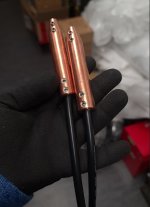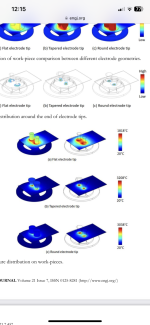That is ok for slower casual welding, but you should watch the connector's temperature while doing that.if i can use a XT 90 connectors instead of xt150
You are using an out of date browser. It may not display this or other websites correctly.
You should upgrade or use an alternative browser.
You should upgrade or use an alternative browser.
kWeld - "Next level" DIY battery spot welder
- Thread starter tatus1969
- Start date
DogDipstick
100 kW
As Hobbyking is often out of stock on my recommended Lipos, I've bought and tested a few more models. I can recommend these two:
Turnigy Nano-Tech Plus 5000mAh 3S 70C Lipo Pack w/XT90 (calibrates at 1570 amps when fully charged)
Turnigy Graphene Panther 5000mAh 3S 75C Battery Pack (calibrates at 1520 amps when fully charged)
Unfortunately, as of writing this, also these have gotten out of stock... My order was just a month ago.
You should try to recommend the Maniax lipo. Perhaps test. They are proving very powerful in the hobby field. Very good at 1mOh / cell for the 5ah cells.

ManiaX Power
ManiaX Power. 2,773 likes · 23 talking about this. ManiaX Power is a professional Lipo & LFP battery products manufacturer & exporter since 2005.
 www.facebook.com
www.facebook.com
DogDipstick
100 kW
My Turnigy Graphene 5.0 4S 75C lipo ripped itself apart when trying to weld a 0.15 nickel 0.20 copper sandwich.
Apparently it’s not recommended to go above 3S because the higher voltage of a 4S battery makes the battery work harder for the same weld as a 3S battery; which becomes a problem for thick welds that demand higher joules to complete.
I don’t remember the interesting specifics off hand, so maybe someone else can speak to that, but (correct me if I’m wrong) it’s something to do with the weld (resistance weld) being performed by current, not volts, so higher volts isn’t very useful, but is stressful.
If a weld needs 1600 amps, but the battery providing those Amps is several Volts higher because it’s a 4S instead of a 3S, the total Power rushing through the battery terminals and kWeld power rails will be higher and more stressful to the conductors (in my case the pouch cell tab conductors are what failed).
The weld just cares about current, not volts. Higher volts means more power flows through the conductors during a weld, stressing things out.
No.. no. I do not think the machine works this way.
Read this entire thread, including the short response Tatus gave to me, years ago, in reference to how the a machine see the higher voltage and his recommendation to me when I was having severe overcurrent with my way-to-powerful cell of choice. I could not weld, for the pack was to strong.
I use Chevy Volt cells. I must discharge the pack, 1/2 of capacity, or unless I receive over-current protections. A pack cost about 20$ and is not able to be destroyed by the tab engulfing in ablation. The cells are very hardy.
Our discussion was prior.
This pack still stands today unaffected by age, or use. It is a recycled electric car cell from a hybrid Chevrolet...
...there are many hobby grade lithium polymer cells you can source ( I even know of claimed "200C" 5 aH cells available, 30$ ea retail, designed fro drag race enviroment lol. . ) that are better than the out-of-stock offerings of Hobbyking. For less moneytoo. the thing HK has going for it.. is warranty replacement. They will warranty a pack with zero questions asked.
Fullymax, or Maniax, is what we are all flying today, in our helicopter. Some options that maybe in stock.
BVH
1 kW
- Joined
- Mar 26, 2009
- Messages
- 411
If you want good, solid professional test results of all the most popular name brands of Lipos, go here. The table on page on is always current. Another round of annual testing is not far off.You should try to recommend the Maniax lipo. Perhaps test. They are proving very powerful in the hobby field. Very good at 1mOh / cell for the 5ah cells.

ManiaX Power
ManiaX Power. 2,773 likes · 23 talking about this. ManiaX Power is a professional Lipo & LFP battery products manufacturer & exporter since 2005.www.facebook.com
Battery Load Test Comparisons - RC Groups
Battery Load Test Comparisons Batteries and Chargers
DogDipstick
100 kW
Yes and you can even ask Wayne or MSCGuy questions personally and they will respond certainly. On how Wayne made that system to test those packs.If you want good, solid professional test results of all the most popular name brands of Lipos, go here. The table on page on is always current. Another round of annual testing is not far off.
Battery Load Test Comparisons - RC Groups
Battery Load Test Comparisons Batteries and Chargerswww.rcgroups.com
Wayne is a great guy. I have asked him to put my Chevy Volt battery on the list but they wont lol. They only will put 5-6aH flight packs on the list. I for sure tried to send them some to get on the list lol.
Last edited:
I looking for the same handle you use on Aliexpress, do you recommend me it ? how is the loose in all axis ? and how is the Heat at 60J when you spot every 2~3 sec ?I managed to update my welder.
First I had a 11.1v 260ah lipo that I used as main power source. This battery gave 1500a currents when charged at 11.1-11.2v, never went higher.
Now with the supercaps and the new wiring the story changes.
I get 1500a when I charge the supercaps to 5.5V. I tried higher voltages(from 5.6v to 8.1v, I didn’t charge more the caps)only for the calibration where I get 1800a and overcurrent alarm.
As a short test I tried to weld 0.15Ni + 0.1Cu to a 21700 cell using 30J. The weldings were always consistent.
I still have to wrap the caps in a pvc heat shrink and fix the welder to the block but overall I am very glad of the outcome.
I went with the supercaps because the battery was way too heavy and bulky to carry around and also enough dangerous!
Thanks Frank for the recently sent kSupply.
One small question, I know for sure that at with the caps at 5.5v my welder gives 1500a.
If I set the undercurrent protection to 1200a the welder gives an error without doing the weld.
If I lower the the value to 900a it works.
Same thing happened with the battery too.
How can one properly chose or calculate this value?
link https://fr.aliexpress.com/item/1005002655307336.html?spm=a2g0o.detail.1000060.2.45ee6f60apBxS0&gps-id=pcDetailBottomMoreThisSeller&scm=1007.13339.291025.0&scm_id=1007.13339.291025.0&scm-url=1007.13339.291025.0&pvid=91574440-d321-42a5-a179-cb9e36132f5c&_t=gps-id
Last edited:
I just bough a Kweld complete set, and i am little bit disappointed
1- Kweld doesn't have basic On/Off button or Input for that, for Turn off the welder it's need disconnect the main power line, it's a bit crazy, add a switch for disconnect the logic power supply Cost 0$ more or energy to do at the dev time
2- the software is so basic, really basic, he doesn't have two or three pulse configurable as all semi-pro or pro spot welder machine, after buying it i searching why the pro machine have two or three pulse, Even Capacitors/mosfets based units, because with transformer it can be logic to follow the AC, but it's not only for that and it's useful i explain more down.
3 -Kweld complet set are just not able to spot repeatedly without overheating, after less than ~15 spots it is already impossible to hold the Pen and all the cables are so hot, and with just ~50 Joules (it mean, he loose so much energy in the line when it should be in the solder point) 8 Awg is soo bad choice, 6 is better but still too weak
4 - it's limited at 2000A (one guy said at 1800a he already get the Alarm) when for less than that price you have Capacitor based spot welder complete can go at 1800A for around 180$ shipped, and up to 6000A for some Serious one around 500$ with Capacitors/mosfets typologie, i never try it because many ppl pull up the Kweld as the best but so i dont feel it when i use it ...
so, considering the necessity to bough the Kweld at ~210€ Shipped + Buy Separately Another Handle, Another Wires bigger, and Bough power supply As multiples big Lipo or Capacitors and considering the others points, the fact that need to re-set the energy we need at every start, because every time i disconnect and reconnect it come back to 10J ... so yeah, i am a bit disappointed, I've been too hype by my friends and by random ppl on internet and finally I'm disappointed, it's neither a semi pro tool even less pro, it's good to spend a days spotting a battery, and sip a drink every 10 spots for the let cool down all the Kweld Set, and not get the best spots because of the lack of the multi pulses and because of the low current capacity also, in my case it up until 1300~1400A at best, and it's enough to be impossible to use after some spots as i explained
for the multiples pulses adjustable :
"Professional spot welders often use two pulses instead of one for several reasons.
Firstly, using two welding pulses allows for better heat control and minimizes deformation of the parts being welded. The first pulse establishes the electrical contact between the two parts being welded, while the second pulse provides the energy necessary to create the weld. By using two distinct pulses, the amount of heat applied to the part can be better controlled, reducing the risk of deformation or damage to the part.
Furthermore, using two pulses can also result in stronger and more durable welds. By using the first pulse to establish electrical contact, the second pulse can be used to create a deeper and more homogenous weld, increasing the mechanical strength of the weld.
Finally, using two pulses can also help reduce spatter and splashes during the welding process, which can improve the quality of the weld and reduce the risk of defects or damage to the part.
In summary, using two welding pulses in professional spot welders allows for better heat control, stronger and more durable welds, and reduced spatter and splashes."
I saw the images of the KweldPro which will come out around 1000€ for the Pcb only, it uses the same number of Mosfets than the Kweld and the same typology as the curent Kweld, it just integrate a screen and additional capacitors, it is not necessary to have a screen to have fonctions more complete & versatile software and to integrate functions such as multi-pulse, can you already offer to your customers a firmware update ?? in order to be able to at least :
1- get the multi pulse (3) configurable in Joule per pulse and delay between pulses?
2- have a standby mode if you can't turn it off without unplugging it, if we can turn off the screen it can be a good start (can be turn off the screen automatically after inactive time also (but maybe you dont have circuit to control the backlight ..)
3- increase the memory management, that at least it keeps the preferences after power off
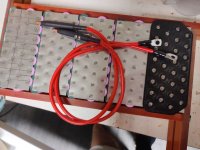 that Parts totally useless, i stop to use it after less than 20mn when i realize how useless it is
that Parts totally useless, i stop to use it after less than 20mn when i realize how useless it is
 i modify the Box to had a fan on it, if someone are interested i can share the STL
i modify the Box to had a fan on it, if someone are interested i can share the STL
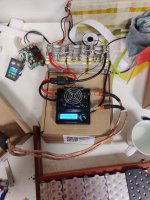 my temporary installation, with Free recuperation battery and temporary handle too, it's friend who gave me it but it's shit too, it heat less than the handles in the complete kit but still too much and it have A LOTS of loose, i looking for something else but i am not sure wish one yet, i dont want buy again for something and be disappointed
my temporary installation, with Free recuperation battery and temporary handle too, it's friend who gave me it but it's shit too, it heat less than the handles in the complete kit but still too much and it have A LOTS of loose, i looking for something else but i am not sure wish one yet, i dont want buy again for something and be disappointed
1- Kweld doesn't have basic On/Off button or Input for that, for Turn off the welder it's need disconnect the main power line, it's a bit crazy, add a switch for disconnect the logic power supply Cost 0$ more or energy to do at the dev time
2- the software is so basic, really basic, he doesn't have two or three pulse configurable as all semi-pro or pro spot welder machine, after buying it i searching why the pro machine have two or three pulse, Even Capacitors/mosfets based units, because with transformer it can be logic to follow the AC, but it's not only for that and it's useful i explain more down.
3 -Kweld complet set are just not able to spot repeatedly without overheating, after less than ~15 spots it is already impossible to hold the Pen and all the cables are so hot, and with just ~50 Joules (it mean, he loose so much energy in the line when it should be in the solder point) 8 Awg is soo bad choice, 6 is better but still too weak
4 - it's limited at 2000A (one guy said at 1800a he already get the Alarm) when for less than that price you have Capacitor based spot welder complete can go at 1800A for around 180$ shipped, and up to 6000A for some Serious one around 500$ with Capacitors/mosfets typologie, i never try it because many ppl pull up the Kweld as the best but so i dont feel it when i use it ...
so, considering the necessity to bough the Kweld at ~210€ Shipped + Buy Separately Another Handle, Another Wires bigger, and Bough power supply As multiples big Lipo or Capacitors and considering the others points, the fact that need to re-set the energy we need at every start, because every time i disconnect and reconnect it come back to 10J ... so yeah, i am a bit disappointed, I've been too hype by my friends and by random ppl on internet and finally I'm disappointed, it's neither a semi pro tool even less pro, it's good to spend a days spotting a battery, and sip a drink every 10 spots for the let cool down all the Kweld Set, and not get the best spots because of the lack of the multi pulses and because of the low current capacity also, in my case it up until 1300~1400A at best, and it's enough to be impossible to use after some spots as i explained
for the multiples pulses adjustable :
"Professional spot welders often use two pulses instead of one for several reasons.
Firstly, using two welding pulses allows for better heat control and minimizes deformation of the parts being welded. The first pulse establishes the electrical contact between the two parts being welded, while the second pulse provides the energy necessary to create the weld. By using two distinct pulses, the amount of heat applied to the part can be better controlled, reducing the risk of deformation or damage to the part.
Furthermore, using two pulses can also result in stronger and more durable welds. By using the first pulse to establish electrical contact, the second pulse can be used to create a deeper and more homogenous weld, increasing the mechanical strength of the weld.
Finally, using two pulses can also help reduce spatter and splashes during the welding process, which can improve the quality of the weld and reduce the risk of defects or damage to the part.
In summary, using two welding pulses in professional spot welders allows for better heat control, stronger and more durable welds, and reduced spatter and splashes."
I saw the images of the KweldPro which will come out around 1000€ for the Pcb only, it uses the same number of Mosfets than the Kweld and the same typology as the curent Kweld, it just integrate a screen and additional capacitors, it is not necessary to have a screen to have fonctions more complete & versatile software and to integrate functions such as multi-pulse, can you already offer to your customers a firmware update ?? in order to be able to at least :
1- get the multi pulse (3) configurable in Joule per pulse and delay between pulses?
2- have a standby mode if you can't turn it off without unplugging it, if we can turn off the screen it can be a good start (can be turn off the screen automatically after inactive time also (but maybe you dont have circuit to control the backlight ..)
3- increase the memory management, that at least it keeps the preferences after power off
 that Parts totally useless, i stop to use it after less than 20mn when i realize how useless it is
that Parts totally useless, i stop to use it after less than 20mn when i realize how useless it is i modify the Box to had a fan on it, if someone are interested i can share the STL
i modify the Box to had a fan on it, if someone are interested i can share the STL my temporary installation, with Free recuperation battery and temporary handle too, it's friend who gave me it but it's shit too, it heat less than the handles in the complete kit but still too much and it have A LOTS of loose, i looking for something else but i am not sure wish one yet, i dont want buy again for something and be disappointed
my temporary installation, with Free recuperation battery and temporary handle too, it's friend who gave me it but it's shit too, it heat less than the handles in the complete kit but still too much and it have A LOTS of loose, i looking for something else but i am not sure wish one yet, i dont want buy again for something and be disappointed
Last edited:
999zip999
100 TW
Foujiwara Wow what welder do you suggest. Dual pulse ?
I dont suggest anything yet, I'm learning and day by day know more on that topic, I compare the results with Kweld and others semi-pro and pro weld and finally I realize how much the Kweld is not efficientFoujiwara Wow what welder do you suggest. Dual pulse ?
for exemple he decided to adjust automatically the timing to i inject always the same energy for the point, good idea but if you have less current long time vs more current less time for the same quantity of energy injected, you will absolutely not have the same spot, that what I realize in practice, what we need is very high current in very short time to really weld the material under the tips and not heating it as a light filament, at the best we want to adjust the current of the pulse, and the duration, so we can't adjust this both parameter with Kweld, so we can just the current if we use Caps and adjust the charge voltage of the caps, but I don't have caps, it's another additional high cost
ans also it's not productive to use conic tip because the electrode contact diameter will change as it wears, and for exemple in 50J with 1mm vs 2 mm of contact surface is absolutely not the same, so at 1mm you have a correct spot and 2mm you have your cell not soldered...
that why pro welder have cylindrical tips.. not conic, even if you loose a bit of power in the tip
Last edited:
What i suggest yet it's the Dev of the Kweld offer to users of Kweld a new Firmware to add some features, it can be a good start, after i looking some stuff seem interesting, interesting for Current capacity, with Caps/Mos typology, but seem to dont have much fonctions, just one time duration time adjustment and the voltage of caps who will directly affect the currentFoujiwara Wow what welder do you suggest. Dual pulse ?
Big one, until 6000A on the description : https://fr.aliexpress.com/item/1005005236651955.html?gatewayAdapt=glo2fra
Small one, until 1800A on the description : https://fr.aliexpress.com/item/1005...=20230421043659187430526716500003872651_1&s=p
but i never test it, i can't confirm if it's well or not and if the description is true
Last edited:
Bbbbrass
10 W
Sorry you were disappointed. For the price and results, I am extremely pleased. Have been able to spot weld the nickel copper sandwich well, and much more reliable than the amazon/Ali option I had wasted money on before.
999zip999
100 TW
What type of power do those other welders take it must be 220 v.
I'm interested in having only the base board of kWeld Pro, since I already have capacitors like the pictured ones.My intended price tag is around 1000€ for the prebuilt base unit. Power supply and output cables are extra items. I also have the idea to offer the base board for people wanting to mount their own ultracapacitors (actually kCap will also work with the new unit), but I'm not fully sure. I estimate 3 to 4 months of development work on this, mainly software and steel enclosure, but I have parts already here to build the first 100 units thereafter. These will be prototypes, and international product certification is on the list after these.
But here, I also have a question regarding kCap:
Is it possible to add capacitors to existing kCap, or replace the existing ones?
Main concern is whether the balancing circuit will be able to balance the new or added capacitors. The other thing is, that only at 2 kCap modules the limit of 2000 A is already very close. But 2 kCap modules have only 2x 3S2P of 310 F, which is essentially equivalent to having a 3S system of a 1240 F capacitors. But the smallest capacitors I have are 2000 F each, and they are not used, but brand new. So, it's reasonable to expect, that if I do a modification on kCap, and even if the balancing circuit can balance them, now I will have the problem of an excessive current. Which I can only see solving by using some thinner wires, or lowering the voltage. Thinner wires will create excessive loss and heat. And I suspect, lowering the voltage is limited. To what limit than is possible to lower the voltage? I have also kSupply and an HP server power supply attached, which is currently set at 8,1 V.
Last edited:
Allex
100 MW
Ok, lets hold our horses now.I just bough a Kweld complete set, and i am little bit disappointed
1- Kweld doesn't have basic On/Off button or Input for that, for Turn off the welder it's need disconnect the main power line, it's a bit crazy, add a switch for disconnect the logic power supply Cost 0$ more or energy to do at the dev time
2- the software is so basic, really basic, he doesn't have two or three pulse configurable as all semi-pro or pro spot welder machine, after buying it i searching why the pro machine have two or three pulse, Even Capacitors/mosfets based units, because with transformer it can be logic to follow the AC, but it's not only for that and it's useful i explain more down.
3 -Kweld complet set are just not able to spot repeatedly without overheating, after less than ~15 spots it is already impossible to hold the Pen and all the cables are so hot, and with just ~50 Joules (it mean, he loose so much energy in the line when it should be in the solder point) 8 Awg is soo bad choice, 6 is better but still too weak
4 - it's limited at 2000A (one guy said at 1800a he already get the Alarm) when for less than that price you have Capacitor based spot welder complete can go at 1800A for around 180$ shipped, and up to 6000A for some Serious one around 500$ with Capacitors/mosfets typologie, i never try it because many ppl pull up the Kweld as the best but so i dont feel it when i use it ...
so, considering the necessity to bough the Kweld at ~210€ Shipped + Buy Separately Another Handle, Another Wires bigger, and Bough power supply As multiples big Lipo or Capacitors and considering the others points, the fact that need to re-set the energy we need at every start, because every time i disconnect and reconnect it come back to 10J ... so yeah, i am a bit disappointed, I've been too hype by my friends and by random ppl on internet and finally I'm disappointed, it's neither a semi pro tool even less pro, it's good to spend a days spotting a battery, and sip a drink every 10 spots for the let cool down all the Kweld Set, and not get the best spots because of the lack of the multi pulses and because of the low current capacity also, in my case it up until 1300~1400A at best, and it's enough to be impossible to use after some spots as i explained
for the multiples pulses adjustable :
"Professional spot welders often use two pulses instead of one for several reasons.
Firstly, using two welding pulses allows for better heat control and minimizes deformation of the parts being welded. The first pulse establishes the electrical contact between the two parts being welded, while the second pulse provides the energy necessary to create the weld. By using two distinct pulses, the amount of heat applied to the part can be better controlled, reducing the risk of deformation or damage to the part.
Furthermore, using two pulses can also result in stronger and more durable welds. By using the first pulse to establish electrical contact, the second pulse can be used to create a deeper and more homogenous weld, increasing the mechanical strength of the weld.
Finally, using two pulses can also help reduce spatter and splashes during the welding process, which can improve the quality of the weld and reduce the risk of defects or damage to the part.
In summary, using two welding pulses in professional spot welders allows for better heat control, stronger and more durable welds, and reduced spatter and splashes."
I saw the images of the KweldPro which will come out around 1000€ for the Pcb only, it uses the same number of Mosfets than the Kweld and the same typology as the curent Kweld, it just integrate a screen and additional capacitors, it is not necessary to have a screen to have fonctions more complete & versatile software and to integrate functions such as multi-pulse, can you already offer to your customers a firmware update ?? in order to be able to at least :
1- get the multi pulse (3) configurable in Joule per pulse and delay between pulses?
2- have a standby mode if you can't turn it off without unplugging it, if we can turn off the screen it can be a good start (can be turn off the screen automatically after inactive time also (but maybe you dont have circuit to control the backlight ..)
3- increase the memory management, that at least it keeps the preferences after power off
View attachment 333017that Parts totally useless, i stop to use it after less than 20mn when i realize how useless it is
View attachment 333018i modify the Box to had a fan on it, if someone are interested i can share the STL
View attachment 333019my temporary installation, with Free recuperation battery and temporary handle too, it's friend who gave me it but it's shit too, it heat less than the handles in the complete kit but still too much and it have A LOTS of loose, i looking for something else but i am not sure wish one yet, i dont want buy again for something and be disappointed
First of all, what is this in the red ring?
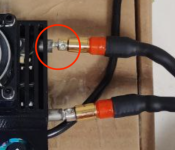
What I see is a thin wire that is Soldered to the cable shoe in one and then soldered to a plug on the other end. Then, it is soldered again before it goes to a wire. There is so much losses in this connection that I dont even want to imagine. Alway crimp your connection when you are handling kiloamps.
I use a 2s3p battery out of a VW golf module with crimped 6AWG wires. The unit never overheats and wires are just warm when I am doing a battery out of 90 cells.

Second. Your welds are way overheated, you can see it by halos, dark melted spots around the spot weld. A properly dialed in welder with a good battery does not need more than 25 Joule to operate and do perfect spotwelds. Here are some pictures for reference on what happens on the other side of the can if you do too much power with 0,2mm nickel.
You can see the joules marked with red marker. See how clean they are:
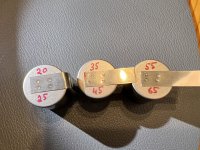
As you can see, at 55/65 you begin to melt unnecessary metal rather than weld.
Lets cut a cell in half and see what happens inside:
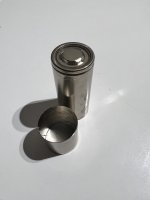
So lets turn the cans, first one is 20 at the top and 25 at the bottom:
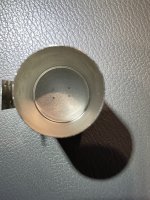
Second is 35/45 at 45 you already start do some damage.

And last is 55/65 well, here you can see that it is excessive

So my welds are good enough at 25J without too much damage to the internals. Of course with different batteries you need to dial different J to get a weld. But this is something to think about. I do also own three 2 pulse welders, but I prefer kweld over the others.
Oh yeah, Pro tip - never weld in the middle of the negative can as you have negative tab attached there.
Last edited:
The unit will come with a 450W power brick (18V / 25A), but you can also operate it from a battery. The onboard ultracap charger is designed for 60 amps, and that should allow for 200 Joules per second at the output terminals. The cable losses will reduce this, but for copper one could use massive ones.
View attachment 330089
Hey Frank,
was muss ich da entdecken
Biete mich gerne als Betatester an. mit den letzten 3 Kwelds hab ich aktuell ~75.000 Zellen hinter mir
Hab den Elektrodenverschleiß nun auch im Griff mit mein "Big Boys"
Attachments
Hi Allex, Thx for your answer, your test with the internal view of the Cell is interesting !Ok, lets hold our horses now.
First of all, what is this in the red ring?
View attachment 333181
What I see is a thin wire that is Soldered to the cable shoe in one and then soldered to a plug on the other end. Then, it is soldered again before it goes to a wire. There is so much losses in this connection that I dont even want to imagine. Alway crimp your connection when you are handling kiloamps.
I use a 2s3p battery out of a VW golf module with crimped 6AWG wires. The unit never overheats and wires are just warm when I am doing a battery out of 90 cells.
View attachment 333182
Second. Your welds are way overheated, you can see it by halos, dark melted spots around the spot weld. A properly dialed in welder with a good battery does not need more than 25 Joule to operate and do perfect spotwelds. Here are some pictures for reference on what happens on the other side of the can if you do too much power with 0,2mm nickel.
You can see the joules marked with red marker. See how clean they are:
View attachment 333183
As you can see, at 55/65 you begin to melt unnecessary metal rather than weld.
Lets cut a cell in half and see what happens inside:
View attachment 333187
So lets turn the cans, first one is 20 at the top and 25 at the bottom:
View attachment 333184
Second is 35/45 at 45 you already start do some damage.
View attachment 333185
And last is 55/65 well, here you can see that it is excessive
View attachment 333186
So my welds are good enough at 25J without too much damage to the internals. Of course with different batteries you need to dial different J to get a weld. But this is something to think about. I do also own three 2 pulse welders, but I prefer kweld over the others.
Oh yeah, Pro tip - never weld in the middle of the negative can as you have negative tab attached there.
First of all, what is this in the red ring?
-it's just a adhesive tape
What I see is a thin wire that is Soldered to ..... :
-for the first point you have right, i just take the first adapter 8mm bullet to hole things for some tests with the handle of my friend because the handle my friend gave me is in bullet 8mm and i take picture at that moment but yeah it's not something you should do and i already had modified that, but i didn't feel any difference to be honest because it full copper good section rigide wire, and on short distance so it's fine, it's the 8Awg heat a lot especially
my complaining was with the complete kit, with the OEM line in 8Awg with the OEM Terminal without modifications, i welded the 8Awg inside the Terminal with very good SN96. Ag3 Cu0.5 so the connection was good but whatever it heat so much fast
but i find the Issues :
1- the Source of the current should be enough to inject much more Current, Cuz a Spot at same "Joule" but at 1000A and 1500A will not make the same result, the first will burn the nickel, the second will weld it
2- The Shape of the Electrode (the surface in contact with the Nickel) change everything, when i reduce the surface touching the Nickel, i start to have good spot at lower joules and then less heat, and it's logic, but if i compare with pro welder, they use 1.5 or 3mm copper electrode, and they dont shape it, and with that, it's not possible to have well spot weld with the Kweld, but if we shape to have very fine extremity of the electrode, yeah it work but very small spot, and also, after some répétitions it need to shape again to maintain the same contact surface to the nickel, it's annoying and not constant ...
but yeah, i agree if we change all on 6 or less Awg, and add lots of good battery to go égal or more than 1500A and also shape the electrode to reduce the surface contact at something less than 0.5~1mm maximum, yeah it can weld and probably in répétition, but it's far from pro welder who get 6kA in répétition with no shaped 1.5 or 3mm electrodes and plus you need to reinject lots of money in the Kweld ....
Then, i ordered that handle in water-cooled , with 50 Square wires (0.3Awg Hahaha), let's see how it will be =) too much ?
And let's me show you how is my connexion now, still 8mm bullet, but i remove the space between the bullet and the hole things, still with Copper bar and brazing inside, i forgot to take picture before put the heat-shrinkable sleeve
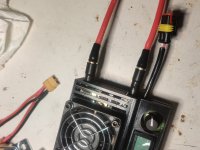
Before, yeah i saw it's burned around the spot, but you know, lots of them was not welded, and i need to remake lots of spots, that what it's heat, i increasing the power again and again, the other side of this battery is just a big shit, i will show you after
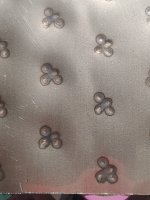
After
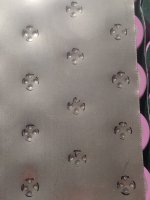
Overview

My Electrode (in the complete kit with the Kweld, Shaped, but already used, i need to re-shape again to reduce the surface contact)
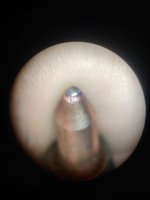
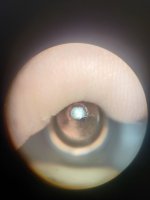
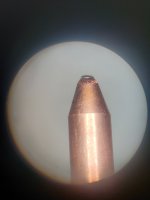
And now i will give you the material for you laughing on me...
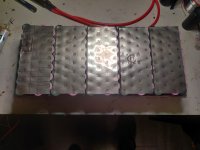
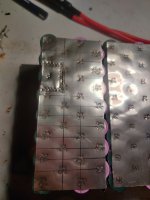
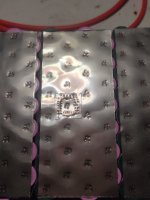
Of course, you can see i I drilled 2 cells because of the irregularity of the weld, one time is not weld, other time is drilled...,
i repaired as I could, change the Cell and made a rustine, it's prototype battery, not so important
Also, i dont know what is your nickel, maybe Iron plated nickel ?, but mine is really 100% Nickel 0.2mm, it need more power than plated nickel to be weld
Last edited:
Allex
100 MW
Those welds do not look good at all. Just melted and not actually welding. What I think happens is that the current is so low from the battery that the kweld needs to do a longer weld and thus overheating. My battery gives me almost 2000A at 3,6V per cell (7,2V total i 2s config) I even need to discharge it to these 3,6V otherwise I get overcurrent. And yes, I weld with 0,2 pure nickel. And what is that white shiny metal on the probes, is that nickel? Might also contribute to bad welds as they should be clean and pure copper only after a weld. Drilled? Are you saying when it explodes and makes a hole in nickel? In this case you are not having a good contact with nickel or both nickel and the cell. It is very hard to weld such large pieces of nickel as you need to press extra hard to get in contact with the cell, otherwise you will have those nasty explosions.
i will be able to say it soon, my friend ordered that one today, after we had again some issues with the Kweld xD like two spot literally at 5 secondes between both, same power, same everything, the first was weak and not soldered and the second make hole in a cell...Any have a comparison between the kweld and us solid(or capacitor based) spot welders? Wanted to make a pack with copper sandwich method.
i am happy, soon we will can compare really if that spot welder is really 6000A, how it work, and how it's made inside
for me it's not true, it good approach but it can't eliminates the need of a cleaning pulse, why you did not implemented the cleaning pulse ? it's just a bit of code linesUpdated schematics (rev.1).
View attachment 217338
View attachment 217339
I plan to implement an energy based pulse control instead of a simple timer. i will try to see how that works with one single pulse, maybe that eliminates the need of a cleaning pulse. Constant energy delivered to the weld spot should result in more consistent welds. The circuit should also be able to detect a failed weld, in this case the requested energy cannot be delivered in a reasonable time.
What do you think about this approach?
Yes I would like to see that. How long till u get it? Most stuff from aliexpress.com take a month to get to me. I usually try to by local vendors.i will be able to say it soon, my friend ordered that one today, after we had again some issues with the Kweld xD like two spot literally at 5 secondes between both, same power, same everything, the first was weak and not soldered and the second make hole in a cell...
i am happy, soon we will can compare really if that spot welder is really 6000A, how it work, and how it's made inside
hello guys, sorry for the late reply but I didn’t get the email notifications from here.
You will need thicker wires between the welder and the pen also between the power source and the welder.
The electrodes that come with the new pen have the bottom part pretty thin which makes them heat and stick to the nickel even at 20j.
You will need to cut entirely that part and adjust the tip accordingly.
To make the electrodes heat less you will need to push them out under 1cm. Less you pull them out less they heat up, the current is higher and the weld is better.
I bought some tellurium rods but didn’t feel the need of using them until now.
There are 3 pen versions from which 2 have air or water cooling. So choose wisely.
The play of the parts inside the pen is close to nothing.
The part that I like most about the pen is I don’t experience anymore blown holes in the strips which I encountered now and then with the original pen because of my shaky hands and a bit of fear every time I did a weld.
Now I can’t recommend nothing to nobody, sorry.
I shared my findings and my suggestions on how to make it work. It’s up to you to decide if it’s worth it or not.
It shouldn’t be the case but it works like that.does this mean that you don't get a double beep error when you set "MinCurr" like this? That shouldnt be the case!
60j every 3s means a lot of heat which requires to optimize a few things.I looking for the same handle you use on Aliexpress, do you recommend me it ? how is the loose in all axis ? and how is the Heat at 60J when you spot every 2~3 sec ?
You will need thicker wires between the welder and the pen also between the power source and the welder.
The electrodes that come with the new pen have the bottom part pretty thin which makes them heat and stick to the nickel even at 20j.
You will need to cut entirely that part and adjust the tip accordingly.
To make the electrodes heat less you will need to push them out under 1cm. Less you pull them out less they heat up, the current is higher and the weld is better.
I bought some tellurium rods but didn’t feel the need of using them until now.
There are 3 pen versions from which 2 have air or water cooling. So choose wisely.
The play of the parts inside the pen is close to nothing.
The part that I like most about the pen is I don’t experience anymore blown holes in the strips which I encountered now and then with the original pen because of my shaky hands and a bit of fear every time I did a weld.
Now I can’t recommend nothing to nobody, sorry.
I shared my findings and my suggestions on how to make it work. It’s up to you to decide if it’s worth it or not.
Attachments
Last edited:
Big one, until 6000A on the description : https://fr.aliexpress.com/item/1005005236651955.html?gatewayAdapt=glo2fra
Small one, until 1800A on the description : https://fr.aliexpress.com/item/1005...=20230421043659187430526716500003872651_1&s=p
but i never test it, i can't confirm if it's well or not and if the description is true
How can you compare something that has already a good reputation (kweld) with some chinese stuff that you know nothing about?
You can set in the welder the default startup value for the joules.
Anyway why do you need so many joules? What are you welding?
My suggestion is first optimize your power source and the connection to it.
When all is optimized you will discover that you will need a lot less joules to weld and everything will be much cooler.
Don’t hurry to complain, instead think a bit what you did different that the others that get good results and are happy with the welder.
Edit. I just seen that you weld 0.2mm nickel. You don’t need 60j for that but more like 20-25j.
Edit2. With 25-30j I weld 0.15mm pure nickel and 0.1mm copper (with the actual pen) with the power source(capacitors) giving 1400-1500a
Last edited:
generally something between 1 week to 1 month depending of lots of things, let's see when we will have itYes I would like to see that. How long till u get it? Most stuff from aliexpress.com take a month to get to me. I usually try to by local vendors.
hello guys, sorry for the late reply but I didn’t get the email notifications from here.
It shouldn’t be the case but it works like that.
60j every 3s means a lot of heat which requires to optimize a few things.
You will need thicker wires between the welder and the pen also between the power source and the welder.
The electrodes that come with the welder have the bottom part pretty thin which makes them heat and stick to the nickel even at 20j.
You will need to cut entirely that part and adjust the tip accordingly.
To make the electrodes heat less you will need to push them out under 1cm. Less you pull them out less they heat up, the current is higher and the weld is better.
I bought some tellurium rods but didn’t feel the need of using them until now.
There are 3 pen versions from which 2 have air or water cooling. So choose wisely.
The play of the parts inside the pen is close to nothing.
The part that I like most about the pen is I don’t experience anymore blown holes in the strips which I encountered now and then with the original pen because of my shaky hands and a bit of fear every time I did a weld.
Now I can’t recommend nothing to nobody, sorry.
I shared my findings and my suggestions on how to make it work. It’s up to you to decide if it’s worth it or not.
"60j every 3s means a lot of heat which requires to optimize a few things."
correction, now i target more 60J every 1~2 sec max for like ~50 repetitions, pause a bit, and continue
"There are 3 pen versions from which 2 have air or water cooling. So choose wisely."
Yes, i choiced the Watercooler one
"The play of the parts inside the pen is close to nothing."
that is what i wanted to know, i want something smooth, without clearance, with the tip enough close to positive tap of 18650, and who dont heat up, good thx
"Now I can’t recommend nothing to nobody, sorry."
i already ordered it week ago, but finally it's like you recommand because you think good about it
documentation complete on what you take the screen if that interest someone
Last edited:
Similar threads
- Replies
- 10
- Views
- 897
- Replies
- 8
- Views
- 3,456
- Replies
- 1
- Views
- 1,604


